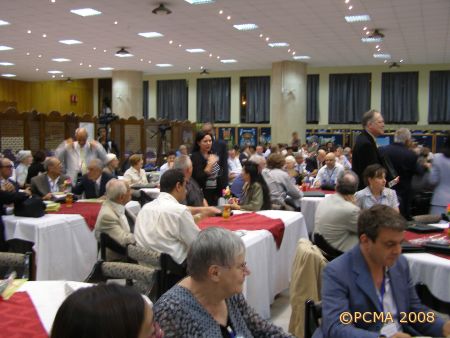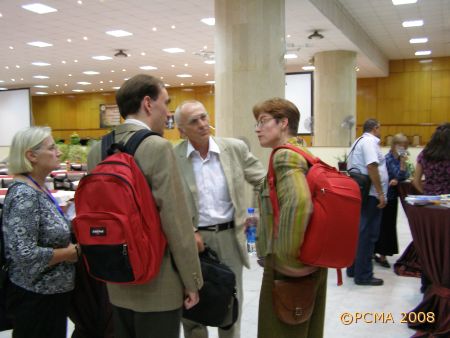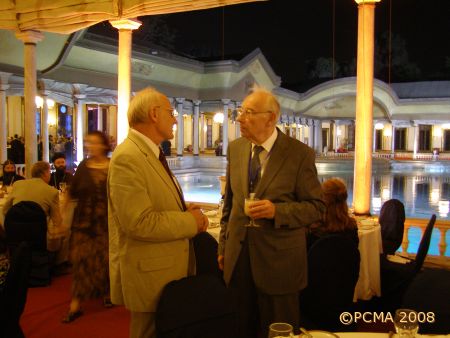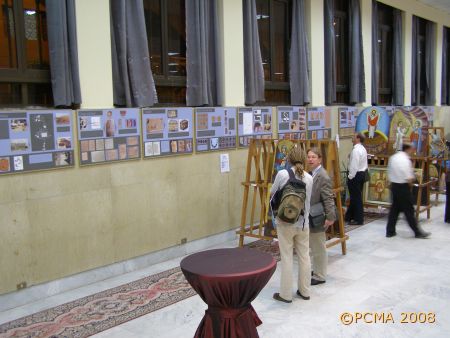Naqlun (Egypt)
Dates: September 1 – October 4, 2008
Team:
Prof. Dr. Włodzimierz Godlewski – director (University of Warsaw, Institute of Archaeology)
Assist. Prof. Tomasz Derda – papyrologist (University of Warsaw, Dept. of Papyrology)
Dr. Christian Gaubert – arabist (IFAO)
Szymon Maślak – archaeologist, documentalist
Grzegorz Ochała – archaeologist, registrar (Polish Academy of Sciences)
Dorota Dzierzbicka – archaeologist, papyrologist (University of Warsaw, Dept. of Papyrology)
Katarzyna Danys – pottery specialist, documentalist
Iwona Zych – worked wood specialist (PCMA)<
Dr. Jarosław Zieliński – archeobotanist (Szczecin Agricultural Academy)
Marzena Ożarek – physical anthropologist
Łukasz Krupski – student of archaeology (University of Warsaw, Institute of Archaeology)
Paweł Niedbał – student of archaeology (University of Warsaw, Institute of Archaeology)
Rania Omar Hendawy – SCA Inspector of Antiquities (Fayum Inspectorate)
A short season (in view of the Moslem month of fasting and holidays, which fell in September this year) necessitated a different approach to the work carried out by the Polish mission on the monastic site of Naqlun this year. Excavations were geared to digging a trench in the refuse dump on Site B in expectation of new papyrological finds. For the site of this trench a spot was chosen within the walls of one of the units of an extensive architectural complex of the 12th century, which was known to occupy the southern part of the area identified as the monastic rubbish dump from earlier times (see report from 1992). This structure comprised a number of units, some with hard floors of lime mortar. At one edge of such a floor there is a damaged circular mark some 2.50 m in diameter, apparently the bedding of some sort of installation. Next to it, a curious checkered field incised in the wet plaster of the floor and around it shoeprints. The opportunity was taken to clean the extant remains of this structure and document it in detail [Fig. 1].
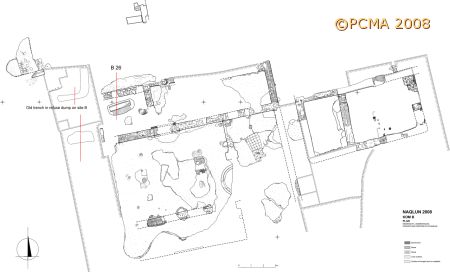
The trench in B26 was dug to a depth of 2.30 m (max. dimensions 3.50-4.80 m). The fill was fairly uniform, consisting of plant remains, ashes, pebbles, brick fragments, and products of human activity, broken pottery in particular, but also basketry, ropes, worked wood, glass, textiles, mud stoppers, lamps [Fig. 2] and the much expected texts on papyrus and paper. This refuse was discarded from the Nekloni monastery, which stood to the north of this area, over a period from the 5th through the 8th century. At the very bottom of the trench, in a layer of sand overlying bedrock, more or less whole LR 7 amphorae were found stacked on their sides. This corresponded to finds of regularly stacked amphorae in the long trench previously dug in the refuse dump (in 1992).
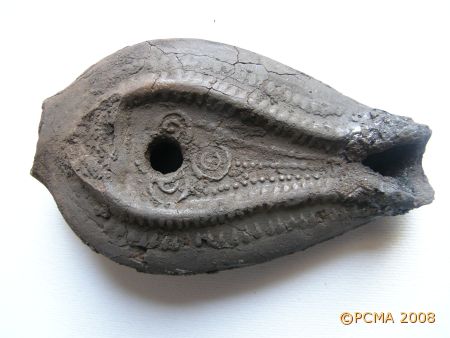
It is not every season that the textual finds from a single trench bring three separate mentions of the name of the site ― in this case, in Greek, Coptic and Arabic! Nd 08.566 was found crumpled into a ball [Fig. 3]. Upon unfolding, the size of this complete official letter, written in a nice, sloping cursive script, was established at c. 33 cm by not less than c. 60 cm. The sender, who is mentioned in the address preserved on the back, is a certain Kyriakos, an official of high rank, writing to a distinguished monk presumably residing in the Naqlun monastery. Considerable sums of money are mentioned in the context of some financial and fiscal operations in the Fayum, notably at Zinnis, a village known from several documents of Fayumic origin. The date is recorded at the end of the letter, in a rather unusual context: ‘I wish you good health for the current 21st year.’ Since the document is to be dated palaeographically to the sixth century, the 21st year should probably refer to the reign of Justinian, i.e., AD 548.
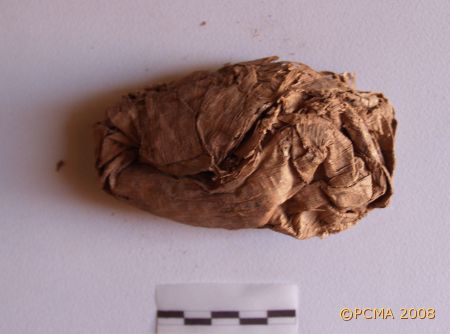
Nd.08.741 is the first Greek text explicitly mentioning the name of the monastery in a 6th century context. The senders are a presbyteros, a deacon and the whole community of the village of Tebetny (in the Fayum, some 10 km west of Naqlun). Unfortunately, the letter is written in Greek so corrupt that its sense escapes understanding ― at least for now [Fig. 4].
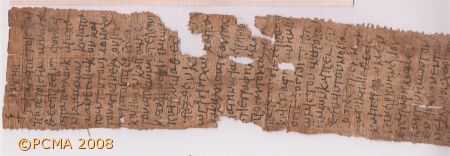
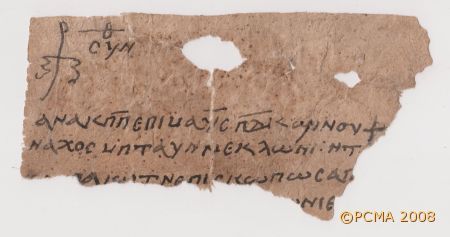
A hardly unexpected find was a burial corresponding chronologically to the 11th-14th cemetery discovered on Kom A. The burial was made obviously after the 12th century structure of which unit B26 was part was abandoned. The walls of the room must have still stood tall enough for the room to serve as a kind of mausoleum. Two individuals had been buried together, a middle-aged man of about 30-40 and an older woman of about 40-50. The man’s body had been placed in a wooden coffin made of palm wood, the woman’s was wrapped in a mat. Both burials were covered with a mat and two baskets were laid on top. The burial clothes in both cases included tunics, some of which bore decoration in the form of Arabic pseudo-inscriptions. The man’s left sleeve was tied into a knot below the hand and inside it, near the palm, a bundle of plant remains was found ― identified as remains of fruit (including pomegranates, apple, grapes, olives, citruses, dates, fruit of Zizyphus spina-christi and celery) ― and a text in Arabic. Both of the deceased had pillows stuffed with plant matter placed under their heads. A comb of olive wood and some glass bottles [Fig. 6] were also found with the burials.
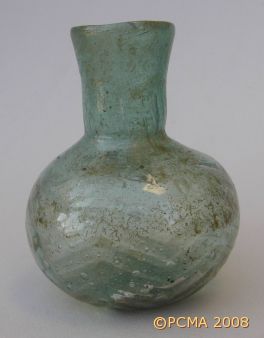
Concurrently with the trench on site B, some testing was carried out in the sector on Kom A investigated in recent seasons [Fig. 7] in order to clarify certain points of interpretation. Two separate buildings were identified as a result of further cleaning and thorough architectural analysis of the remains. The first of these structures, Building K, was built of red brick. A small cellar[Fig. 8] and an adjoining room with vessels sunk into the floor, obviously for storage purposes, were explored. Dating based on pottery finds places this structure in the 9th-10th century. The building to the south (designated as L)is separated from Building K by a narrow alley. It consists of six units, all built of mud brick presumably on the remains of an older structure [Fig. 9]. Here, the pottery and textual finds provide a date in the 10th-11th century.
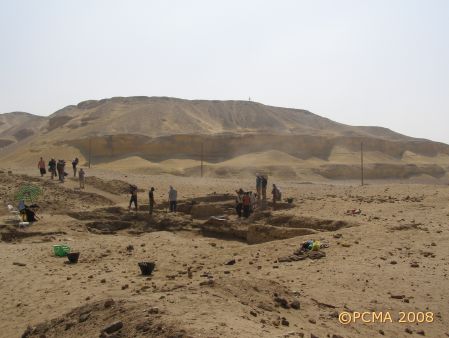
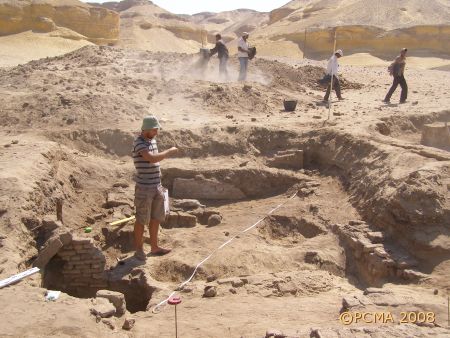
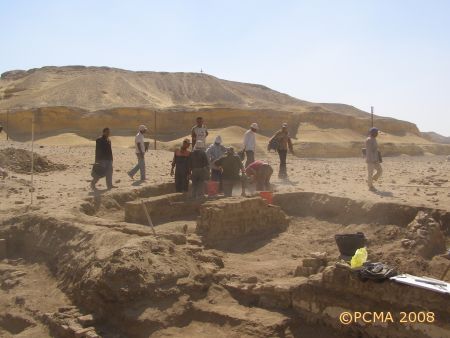
The planned textile conservation program had to be suspended this season for a variety of reasons, but the other study program concerning worked wood from the excavations was implemented successfully. It covered all of the worked wood and plant finds from excavations between 1991 and 2008, collected in the mission’s storehouse in Naqlun. The collection, which is being studied by Iwona Zych for her PhD dissertation, was subjected to archeobotanical examination with the purpose of identifying wood species. Archeobotanist Jarosław Zieliński of the Szczecin Agricultural Academy examined examined a total of 568 objects, mostly based on crosswise, lengthwise and diagonal polished sections, confronted with available archeobotanical literature. Of this number 85 could not be positively identified due to the poor preservation of the wood structure. Local species of trees predominated in the sample with 438 items being made out of locally growing wood. This was mainly tamarisk Tamarix sp. ― 205 samples (Fig. 1), followed closely by ficus or fig-tree ― 161 samples. In view of the fact that most items were made of the tree trunk, it has been assumed that the species in question is Ficus sycamorus. The remaining species of native and traditionally cultivated trees and bushes were represented sporadically. These included acacia Acacia nilotica (32 items), olive tree Olea europaea (31 items), palm tree Hyphaena thebaica and Phoenix dactyliphera (14 items) and willow Salix suberrata (4 items). Tree species not native in Egypt were also recorded in the sample. These included cedar wood Cedrus atlantica ssp. libani (37 items), ebony Diospyros lotus (7 items) and beech Fagus orientalis (1 sample).
The mission took a week off in September in order for some of its members to participate in the 9th International Conference of Coptic Studies, which was held in Cairo on 15-20 September 2008 [Figs 10-12]. Prof. Włodzimierz Godlewski presented a comprehensive lecture on new discoveries in Coptic archaeology in Egypt in the years 2004-2008. Iwona Zych presented the collection of locking devices (keys, bolts and locks) from the monastery at Naqlun. Scholars participating in the conference had the opportunity to view an exhibition of 20 poster-size boards presenting the results of 20 years of excavations at Naqlun [Fig. 13].
